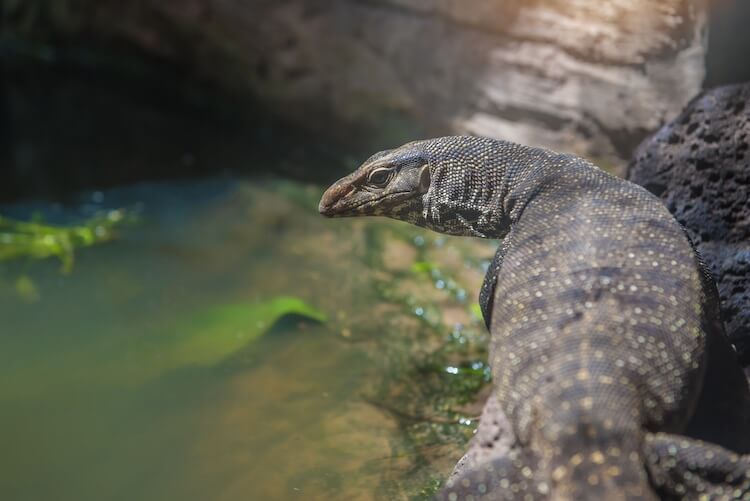
Are you an experienced reptile keeper looking for an intelligent, active and unique pet?
The Asian water monitor is a powerful and intelligent reptile that has a prehistoric appearance straight out of Jurassic Park. It is also one of the largest lizard species on the planet. Asian water monitors grow quickly can reach eight feet.
Because of their giant size and aquatic lifestyle they are a difficult lizard to keep.
Are you ready to dive into the world of water monitors?
Keep reading for a full care sheet with tips on how to feed, house, and handle these miniature dragons.
Species Overview
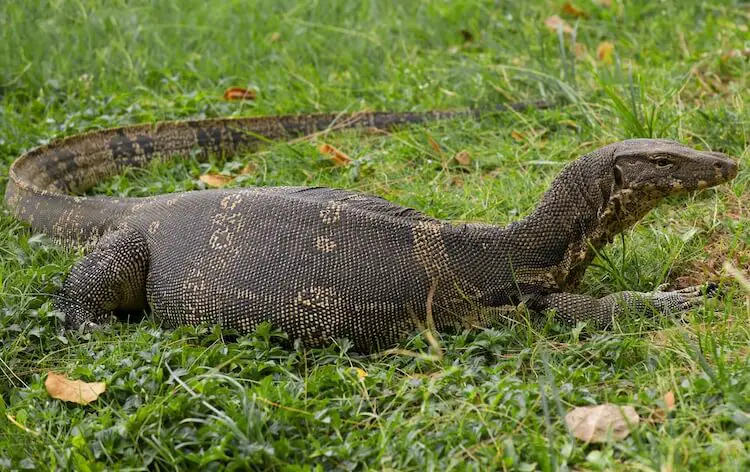
Asian water monitors (Varanus salvator) are lizards in the Varanidae family. Their family is a group of 50 to 60 lizards that includes the iconic Komodo dragon. Water monitors are gigantic reptiles that have been around for millions of years.
This species was first described in 1768 by Josephus Laurenti, an Austrian naturalist. Water monitors have evolved very little since the time of the dinosaurs and they still look prehistoric!
As well as having an appearance straight out of Jurassic Park, these lizards are heavy too. They tip the scales at 44 to 54 pounds. Male adults can grow over eight feet long. Females are slightly shorter, growing up to six feet. Despite their size, monitors are quite agile and can easily climb trees with the help of their curved claws and strong legs.
These large lizards also have impressive tails. Their tails are flat and lined with a ridge of scales to propel them through the water. Their streamlined bodies make them fantastic swimmers. Because of this, they like to live near wetlands, rivers, and lagoons.
Unfortunately, Asian water monitors are hunted in their native range for meat, leather, and medicinal purposes. Even with hunting, their wild population is not decreasing and they are in no danger of becoming extinct.
Can You Keep A Water Monitor As A Pet?
Experienced reptile enthusiasts have been raising these lizards as pets for over twenty years. But, keeping an Asian water monitor as a pet lizard is difficult because of their giant size and aquatic lifestyle.
Asian water monitors need a room-sized enclosure. This enclosure must have areas to climb and swim. They also need a temperature gradient, with highs from 120 to 150°F for basking and lows of 74°F for cooling off.
Heating a room to this temperature can be expensive and hard.
Ideally the enclosure should be set up and running for several weeks before you bring home your monitor. This will ensure the temperature remains stable.
Asian water monitors will also need a proper diet. They should be fed mostly insects, with raw chicken, mice, whole chicks, fish, and eggs. Feeding pet water monitors requires a varied diet and a careful feeding schedule. These giant lizards will often eat as much as they can, to the point where they can easily become obese.
Water monitors are a lot of work, but provide a rewarding and unique experience when cared for properly. Many owners are able to form a bond with their lizard that lasts a lifetime.
Pros
- Bold, curious and inquisitive personality.
- Large size and prehistoric appearance.
Cons
- Require a very large enclosure and lots of heat.
- Very powerful bite and an extremely strong tail.
How To Care For An Asian Water Monitor
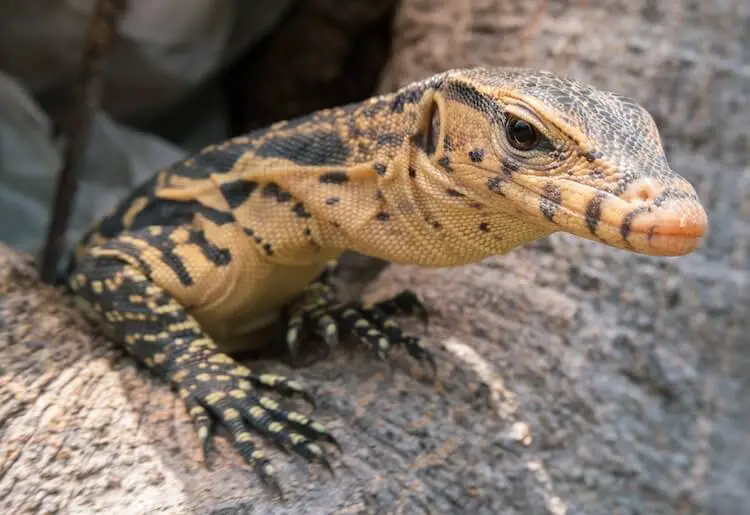
Asian water monitors require a lot of attention and care. They need a complicated and large enclosure, a varied diet and lots of socialization to prevent aggression. They are also very strong and can inflict damaging bites. For these reasons, they are best left to keepers with the experience and money necessary to care for them.
Diet
Asian water monitors are hypercarnivores. This means their diet is 100% meat and wholly consists of other animals and their eggs. There are even reports of water monitors uncovering and eating human remains.
These opportunistic predators eat in both urban and rural environments. This results in a naturally varied diet that includes: rodents, domestic animals, birds, crabs, snakes, lizards, young crocodiles, eggs and turtles.
In captivity, an Asian water monitor needs a lot of food, especially when growing.
Juveniles under one year old should be fed a diet of gut-loaded crickets, cockroaches, mealworms, small fish, and shrimp every day. Feed them using tongs, or in a separate bowl or tray. You want to avoid creating an association between your hand and feeding.
Adults only need to be fed two times a week.
As they become older, you can add in pre-killed chicks, mice, scrambled or hard-boiled eggs, and organ meat.
Varying their diet is important to give your lizard all the nutrition it needs. Different prey also provides enrichment and makes feeding time a fun experience. To supplement their diet, dust feeder insects with a vitamin D3/calcium powder every second meal.
Asian water monitors will rarely miss a meal and can easily become obese. You should adjust the amount you feed based on their size and age. After eating, your lizard should have a slightly rounded belly, but not distended.
Health
Monitors are tough, hardy, and strong reptiles. With the right care, Asian water monitors can live to be 15 to 20 years old, though their lifespan in the wild is much shorter. Most health problems can be avoided by keeping their enclosure clean and within the correct heat and humidity range.
Burns, respiratory infections, and digestive problems are some of the most common health issues.
Burns happen when heat bulbs are placed too close to the basking area, or the basking area is too hot. These lizards need a hot tank, but extreme temperatures over 150°F can lead to fatal tissue burns.
Unlike mammals, reptiles do not have a heat response reflex. They will not pull away from a surface that is too hot. Burns on reptiles look like gray or brown crusty skin patches. Bad burns can even split the skin.
Respiratory infections are often caused by a combination of stress and low temperatures. These infections can be fungal, bacterial or viral. Asian water monitors with an infection often sneeze or cough and breathe with an open mouth.
Low temperatures can also cause digestion problems such as constipation and a reduced appetite. Monitors need a lot of heat to digest their food as it takes so much energy. You can use an infrared temperature gun to make sure the surface temperatures of basking spots are correct without risking burns.
Cage Setup
These lizards live in tropical parts of southeast Asia with lots of water. They love marshes, rivers, lagoons, and flood forests. While they enjoy swimming, they are also excellent climbers. It is not uncommon to find them in treetops, especially when escaping from predators.
Asian water monitors need a large enclosure that has space in all directions.
Their cage should be big enough for them to climb, walk, and soak.
A hatchling can be kept in a small 36” x 30” x 24” enclosure (about 100 gallons) for the first six months. However, as it grows, you will need to move your lizard into a larger enclosure. Ideally an adult should be kept in a converted room or a custom-built cage at least 4’ x 8’ x 8’. Large males may need even more room.
Asian water monitors like a warm, humid environment. Their tank should have a basking spot between 120 and 150°F. You will need to use multiple basking lamps that cover the whole length of your lizard to achieve this.
Ambient temperatures should be in the low 80s. To create a nice temperature gradient keep a cool side at 72 to 74°F. Humidity around 70% is ideal. This should be easy to maintain because of the large bathing area they need.
Water monitors should also have a large area of clean water in their tank. This pool should be long and deep enough for your lizard to submerge its whole body. A pool big enough for some swimming will greatly contribute to your monitor’s mental and physical health.
Adding décor to your lizard’s enclosure is important. Add sturdy branches or pipes, live plants and wooden platforms. This not only increases your cage’s visual appeal, but is also a more enriching and entertaining environment.
Asian water monitors are smart and agile reptiles. They need plenty of opportunities to climb, dig, and explore. Filling most of the tank with two feet of moist substrate will give them plenty of space to dig. A mixture of topsoil, sand, and leaf litter works well.
Handling
Asian water monitors can get used to being handled if introduced to it from a young age. Building trust with your water monitor can take several months, but this long process is both rewarding and very useful. A tame monitor is a lot easier to manage in case of an emergency than a distrustful one!
Start by simply maintaining the enclosure that your lizard lives in.
Once he becomes comfortable with your hands in his enclosure he will slowly approach you. When he willingly approaches you, only then should you attempt handling. Start by holding him for a few seconds in his cage. As he becomes more comfortable, you can gradually transition to handling outside of the enclosure for longer periods of time.
Always watch your monitor’s body language when handling. A stressed monitor can cause harm to itself and you.
Handling should be fun and enjoyable.
Asian Water Monitor Size

Asian water monitors are the second largest lizards in the world, just behind the Komodo dragon. They are much larger than other water dragons.
Males grow larger and faster than females with some reaching over eight feet in length, though five feet is more common. Females will stop growing at between four and six feet.
Asian water monitors start out small but grow rapidly. On average, these lizards weigh 44 to 54 pounds. Though there have been reports of males weighing close to 100 pounds.
Asian Water monitors share many attributes with both land reptiles and water reptiles.
Like the Red-Eyed Skink, this species has a crocodile-like appearance. Monitors have a long, muscular tail, short legs, and a low body. Their powerful tails can be used to help them swim and as a weapon.
Unlike crocodiles, however, these lizards have a slender head on a highly flexible neck. This flexibility allows them to watch their surroundings for prey or predators.
They also have dry, wrinkly skin covered in many small, interlocking keeled scales. Their scales help to provide protection when they clamber over rocks and logs.
Asian water monitors are beautiful lizards with an olive-gray back and light yellow belly. Juveniles have several horizontal rows of white “bullseye” spots that typically fade as they mature. Adults can fade to be nearly black or dark green.
Every adult has a dark stripe running through their eye and down their neck. They also have a black and white striped tail that is ridged on top.
Asian Water Monitor Facts
| Facts Table | |
|---|---|
| Common Name | Common Water Monitor |
| Scientific Name | Varanus salvator |
| Family Name | Varanidae |
| Genus | Varanus |
| Range | Indonesia, Malaysia, Vietnam and Thailand |
| Weight | 4 to 8 feet (males are slightly bigger) |
| Size | 44 to 54 pounds (males are slightly heavier) |
| Lifespan | 15 to 20 years |
| Diet | Insects, with raw chicken, mice, whole chicks, fish, and eggs |
| Popular Alternatives | Green Iguana, Ackie Monitor, Savannah Monitor and Nile Monitor |
Behavior
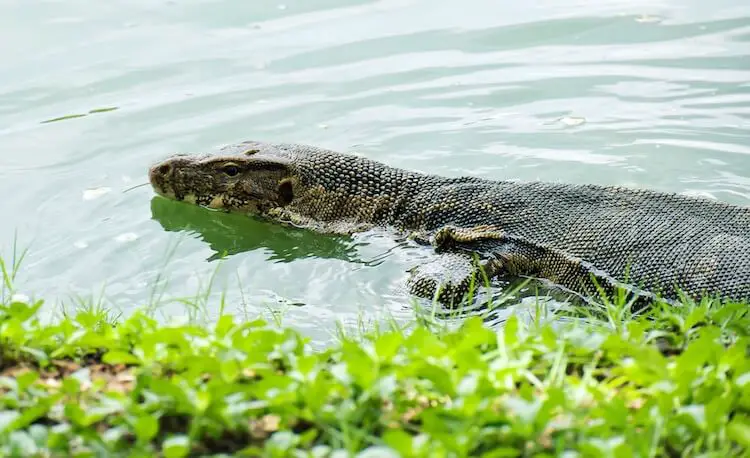
Asian water monitors are often found swimming in lagoons, rivers, and ponds. They are very good swimmers and can even dive underwater for as long as 30 minutes. They will dive in search of fish and crustaceans.
These lizards are not as friendly as the Savannah Monitor but they are still approachable as pets. Curious and calm monitors will flick their tongues at an interesting object. They can be aggressive if they are confronted in the wild or too quickly.
Asian water monitors are brave reptiles. Their size and strength must be respected.
When frightened they will hiss, inflate their bodies, and stand on their hind legs. They may also try to bite or whip their tails at their attacker, but they would rather escape first.
Male monitors are fiercely territorial and will chase any strangers out of their territory.
During mating season, males become more aggressive. They may scent mark trees and other items with secretions from glands in their neck.
In areas with high prey and water density, water monitors can be found in small groups with a dominance hierarchy. Large monitors may intimidate smaller individuals by chasing or slapping them with their tails.
Monitors occasionally participate in ritual combat. Two males will rear up on their hind legs and grapple with each other. This fighting is mostly for show and monitors rarely become injured during the process.
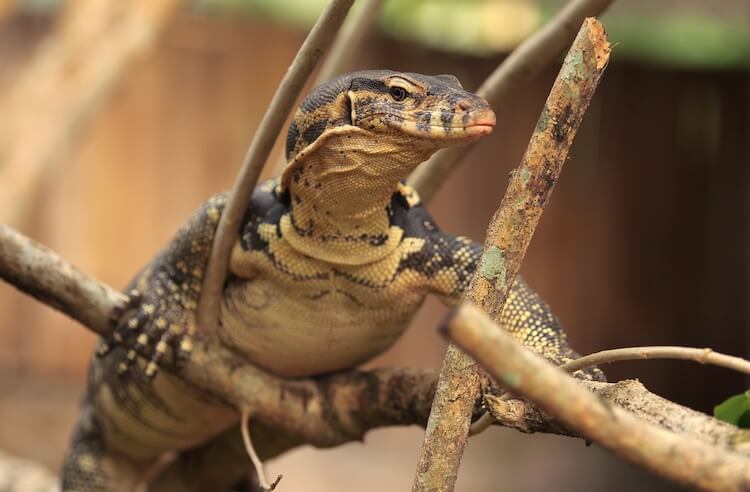
Price and Buying Guide
Hatchlings can be purchased for anywhere from $300 to $15,000. Their age, morph, and tameness all factor into the price. Pre-socialized Asian water monitors are in high demand. They cost much more than individuals unfamiliar with humans as they are easier to keep.
Healthy monitors should be alert, active, and curious.
Buying this lizard is just the beginning.
Because they grow so big, providing a suitable lizard-proofed cage or room will cost several thousand dollars. They can also eat $200 per month on food alone. Keepers who have enough experience to own an Asian water monitor must be prepared to spend lots of money.
Most Asian water monitors available for sale in the United States are captive-bred by private breeders. A seller should be upfront about their pet’s health and housing needs. Their large size and quick growth mean they are unlikely to be found in pet stores.
Wild-caught species should never be purchased. They are usually in poor health and far more aggressive.
Summary
Asian water monitors are the second largest lizard on the planet. Some males can reach over eight feet.
Their size and prehistoric appearance have made them one of the most popular pet monitors. However, their size also makes them a powerful reptile. They can cause serious damage, even to experienced handlers and must be respected.
This species needs a very large enclosure (room-sized) and a varied diet. They should be fed a diet of chicks, fish, shrimp, insects and mice.
Asian water monitors can make unique pets for anyone who has lots of time, experience and money. With the best care, these giant lizards can live for more than 15 years. Some species even become tame and seek out human contact.
Are you ready to bring home this miniature Komodo dragon? Let us know in the comments.

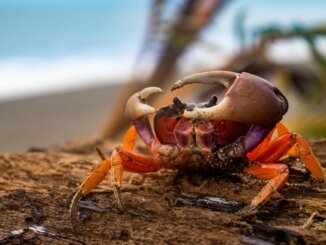
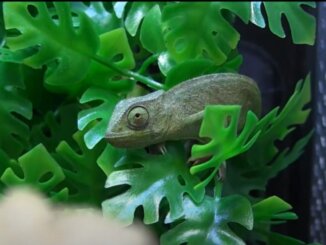
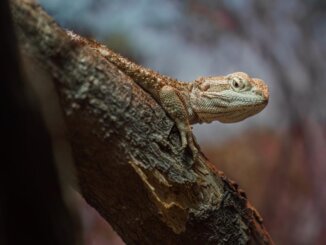
Is this guy good for a beginner without any experience
No, I would say start with a smaller monitor, like a Savannah as they are far more friendly for a beginner. You dont want to get bitten or whipped buy a large monitor like these beauties! Best to get hands on training with something smaller.